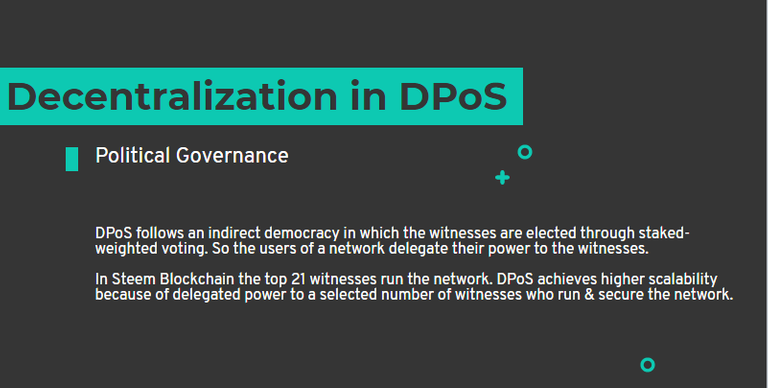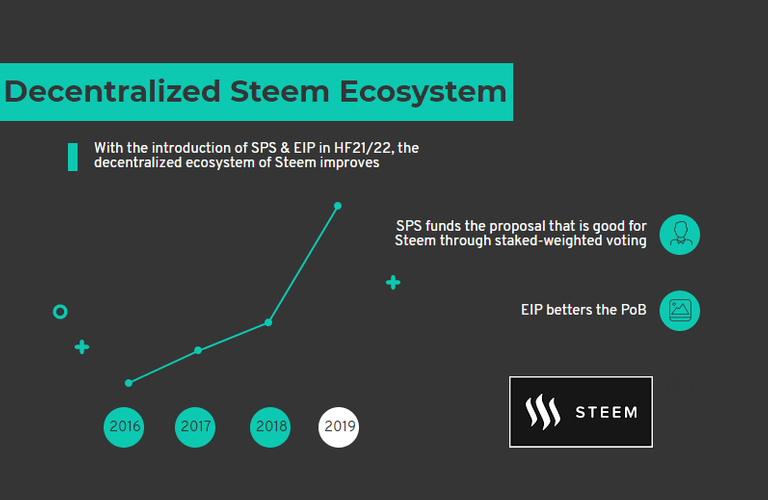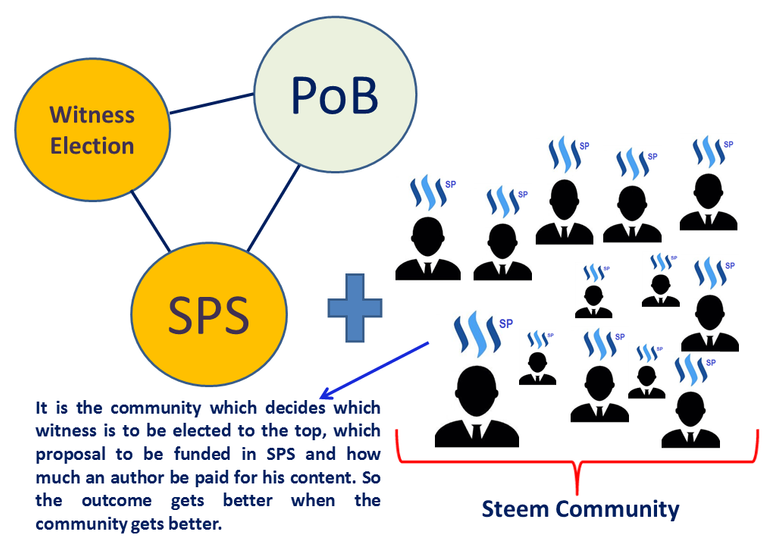Traditionally in a centralized system, a single ledger(or record) with a central authority exists. The trust with the central authority is governed by either law or authoritarianism. The exchange between any two users in a centralized system is routed through that central authority every time an exchange happens. In other words, you are indirectly appointing a third party for an exchange with another peer you want to, and you don’t have any other choice than to trust that person and that trust is governed by the law. Furthermore, there is no provision to check the manipulation in such a system.
In a decentralized system, you also have a ledger(or record), but that is a distributed one, so instead of just one central authority, there are multiple participants who have a copy of that ledger. That is why it called distributed in its first place. This ledger is governed by technology, not by law. Since it is governed by technology it can be made append only and immutable. The exchange between two parties does not require any third party to realize a transaction.
When a distributed, append only & immutable ledger is created or generated by a participant of the network, then it is called as block and when a number such blocks are created in the network, since it is append only, it results in a chain-of-block, what we call it as “Blockchain”.

Fundamental Building Blocks of Blockchain
Ledger- In a blockchain, the ledger is append only and immutable.
It is append only means, only new data can be added.
It is immutable means the data cannot be erased.
These are the two most important fundamental properties which give rise to many use-cases and solve the existing problem interface of traditional centralized systems.
Cryptography- It is an essential tool that ensures authentication and validation of a transaction. In simple words, cryptography ensures information integrity in the blockchain.
Consensus- The network participants in a decentralized system follow a certain algorithm to reach a consensus and that consensus empowers the network to verify a transaction. In simple words, a set of rule is first defined through the governance of the blockchain. By the term governance, again it is the network participant who defines that set of rules and based on that rule, the blockchain operation is carried out.
Now while the above are fundamental to a Blockchain, its governance will further establish how a blockchain is a decentralized one or not. The governance slightly varies depending upon a consensus method. For example, the governance in PoW (proof-of-work) will be different from a DPoS(Delegated-proof-of-stake) consensus.
What does decentralization mean?
While there are different types of decentralization such as geographical decentralization, architectural decentralization, political decentralization, etc, we will delve more into political decentralization because that is the human act that ultimately controls and governs a network and eventually set or modify the rule of a network.
Geographical decentralization means what is the extent of proportional distribution in terms of geography in the network. For instance, suppose there are people from 3 different continents in a network, then are the number of nodes that are running to keep up the network proportionally in the same number in terms of geography? If yes, then it is geographically decentralized.
Similarly, architectural decentralization means how many physical devices that are running the nodes of network are present. If they are more in numbers then the extent of decentralization is more and vice versa.
Now coming to politicial decentralization which also depends on the type of consensus. For example, in Steem Blockchain, the consensus method is DPoS(Delegated-proof-of-stake). It is a kind of indirect democracy where the witnesses are elected based on stake-weighted voting and the top 21 witnesses validate the block, secure the network of Steem blockchain. There is a reason to adopt this mechanism. Since Steem Blockchain basically caters to a social media platform it is essential to enhance the scalability which has traditionally been a bottleneck of blockchain technology, and direct democracy may not yield sufficient scalability. So to match with a centralized social media like Twitter(which can scale 5000 tweets per second), DPoS consensus was adopted in Steem Blockchain and its scaling capacity is more than 10000 transactions per second.

DPoS looks fine from that point of view(to achieve scalability) when we choose representative democracy in the network where the power to run the network is delegated by the individuals of the network to the top 21 witnesses who are responsible for securing the network and amend the rule as and when needed(after reaching a consensus of at least 17 witnesses).
But as we move to the second tier, then we have to look whether stake(SP) using which the individuals vote, are sufficiently decentralized or not in Steem Blockchain. If yes, then again it is fine, if not then even though the representative democracy looks fine in the first tier it is actually not, in the second tier.
Unlike PoW where the top mining pools are skewed which raises concern of 51% attack, in DPoS the same curve is flat because the top 21 witnesses of Steem network validates the same number of blocks by altering their position every 3 seconds. But the DPoS setup cannot be diagnosed in that way in the context of decentralization. So the stake distribution is much more important to properly analyze the extent of decentralization in DPoS because ultimately those witnesses will be elected who is voted the most in terms of Stake equivalent.
If we go back to history of Steem network, then we can find that it was burdened with almost 30%(of the total in Steem network) stake held with Steemit Inc. In its first place it was understood that Steemit was the first-ever dapp on the top of Steem Blockchain and it was also the lead software developer. So the Steem community was aware of the burden as well as the responsibility that burden was carrying at that point of time. But as the Steem community evolved many people joined this community including the developers, who worked for the highest objective of the ethos of the decentralized network.

As we all know Steem network has gone through many hardforks, but the revolutionary hardfork I consider was HF21/22 because it addressed the long-standing issues of Steem community and introduced EIP(Economic Improvement Plan) & SPS(Steem Proposal System). I consider both as historical because, through SPS, many individual developers can be empowered to manifest the greatness of Steem. Through SPS any individual can propose anything which is vetted through the voting system (again stake based) in the community and if qualifies the SPS funds that proposal. So SPS coherently works with the term “community”. In simple terms, if the community thinks that something proposed by someone is good for the community they everyone will pay it, else no one will it. Again I want to emphasize that either way the term “community” is empowered here.
But sadly some lateral entry with malicious intent is now trying the disrupt the very idea of "community" and "decentralization" of Steem network.
So the idea was that the responsibility that the burden (30% stake by Steemit Inc) was carrying can slowly be reduced and can be made more decentralized through SPS. Therefore there was a consensus between Steemit Inc and the community that the 30% ninja mined stake should not be utilized for personal gain nor should be used for political governance of Steem network. It was mutually agreed upon between Steemit Inc and the community.
But as the community evolved better and better in its discourse particularly after HF21/22 with the introduction SteemDAO, Steemit INC suddenly behaved abruptly and breached that agreement between Steemit Inc and Steem community by selling the 30% ninja mined stake to Justin Sun of Tron foundation. This is no less than a criminal offense. Now the person Justin Sun who has taken over that 30% ninja mined stake is hostile to Steem community and it is clearly evident when that 30% ninja mined stake is now being used to twist the political governance of decentralized Steem network.
Being the founder of Tron network, Justin Sun should realize that by principle the decentralization is very fundamental to a public blockchain, no matter which one it is. Even if he was not aware of the said agreement between Steemit Inc and Steem community, at least after knowing the facts he should have responded appropriately for the highest objective of decentralized Steem network. Steem community welcomes Justin Sun wholeheartedly as long as he is integral to the term “community”. By using that ninja mined stake (which is 30% of the total stake of Steem network) to interfere with the political governance of Steem network what does he want to justify? He does not want a decentralized Steem network? Now since he has acquired the 30% ninja mined Stake from Ned, he thinks he is the kingmaker? Well Steem network is not obliged to Tron nor Justin Sun (even if 30% stake is with them as a result of #hostiletakeover). That is why the community is united yet again to resist such a move by Justin Sun. The Steem community will remain united for the highest objective of the “decentralization” & “community”. An individual or a single company can not dictate upon this network especially through #hostiletakeover.
The 30% ninja mined stake is not an organically evolved stake either; that is why I object such a move by Ned and such an act by Justin Sun. During the last downtrend, the middle-class community has grown and that has evolved organically. So the net stake of the middle-class community of Steem has grown after 2018. We want such an evolution. That is a really good sign of decentralization. Had Justin Sun bought 75 million STEEM from the free open market then I would not have objected. Because buying a STEEM token is also a kind of support to the community. But the STEEM that is available in an open free market and the ninja mined STEEM are different. That is why the objection is. Even after communication, Justin Sun did not respond appropriately & the situation becomes worst when with that stake he tried to manipulate the political governance, trying to dismantle the very idea of decentralization.
It is true that the price of STEEM has slided continuously from an all-time high of 8 USD, but the Blockchain is not just about the price, it has chapters that unfold every day, we live those chapters every day and turn up one after the other. What a community and the associated Blockchain wants is organic evolution with a decentralized spirit. There are people who put their utmost effort to make Steem great yet again, but the kind of episode that unfolded since Feb 14 is really a setback for the community and that is why the Steem community stands united to fight such a move. Especially Steem network say a big NO to the interference to its political governance especially with 30% ninja mined stake.
An economic model and an ecosystem can only be made richer when it is decentralized. When it is about Steem ecosystem--- be it PoB(proof-of-brain) or SPS or Political governance in witness election, everywhere it is the coordinated effort of the community to keep the decentralized spirit intact.

In PoB, the author post a blog, the community users apply their knowledge to determine how good that content is and accordingly vote. In SPS, anyone can propose and if that is perceived well enough among the users of the community then through stake based voting it is funded by SPS. Similarly in political governance, we(the community) elect the top witnesses who run the network of Steem.
We the community of Steem always choose to be decentralized, by saying that we bring a prospect in that table which is long-lasting and we also imbibe a culture that fosters generation to generations. That is our long term goal which can only and only be achieved through a decentralized community.The #hostiletakeover of Steem in some form or the other is an attempt to either make it centralized or to engineer a mutiny in Steem network. But the Steem “community” resists such an attempt.
The inforgraphics are my original works.
click hereThis is my entry to the invtation called by @theycallmedan. For more details please
Twitter#posh-